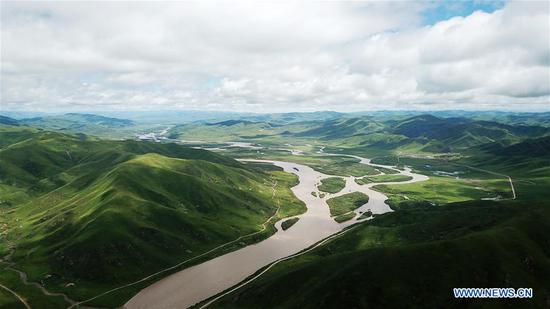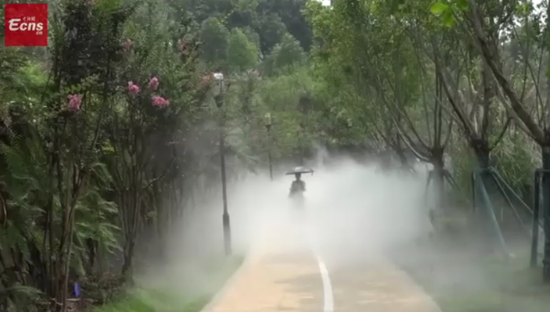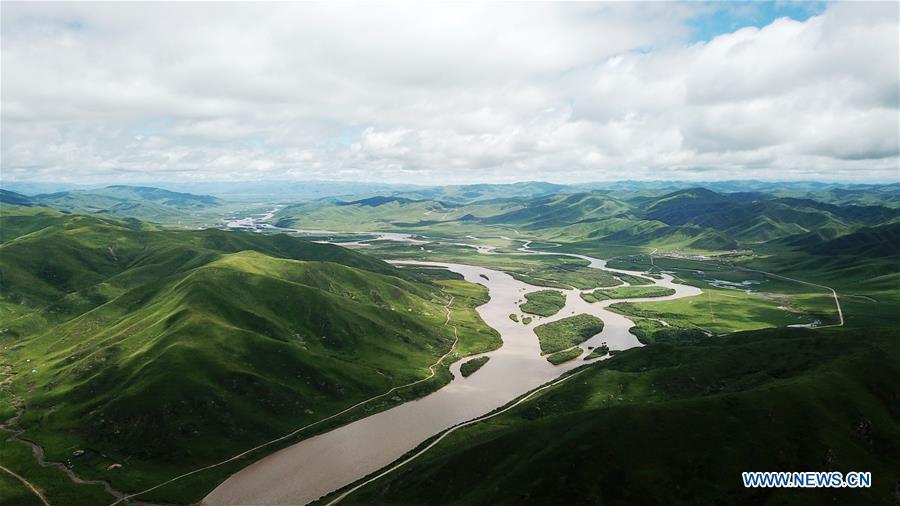
Aerial photo taken on June 23, 2019 shows the scenery of wetland and grasslands in Maqu County of Gannan Tibetan Autonomous Prefecture, northwest China's Gansu Province. Located in the convergence zone of the Loess Plateau, the Mongolian Plateau and the Qinghai-Tibet Plateau, Gansu Province in northwest China strides across various landforms including grasslands, forests, deserts, wetlands and mountains. In recent years, through persistent efforts on protecting water conservation area, containing desertification and resuming forests from farmlands, the ecological environment of Gansu has witnessed continuous improvement. Qilian Mountains, an important protection barrier of ecological system in western China, has nourished vast lands in the Hexi Corridor with rich snowmelt, which enables farmlands there to become a major production area of commodity grain and industrial crops. Gannan Tibetan Autonomous Prefecture in southern Gansu acts as an ecological function area for water supplement of the Yellow River and biodiversity of Qinling-Bashan mountainous regions. More than 7.3 million mu (about 486,667 hectares) of wetland in Gannan supplies over ten billion of cubic meters of water to the Yellow River. Featuring various landscapes and colorful cultures, Gansu Province has become a great attraction among tourists at home and abroad. From Aug. 25 to 27, the "Gansu Day" event is held at the ongoing Beijing International Horticultural Exhibition, in which a diversified Gansu is exhibited. (Xinhua/Chen Bin)
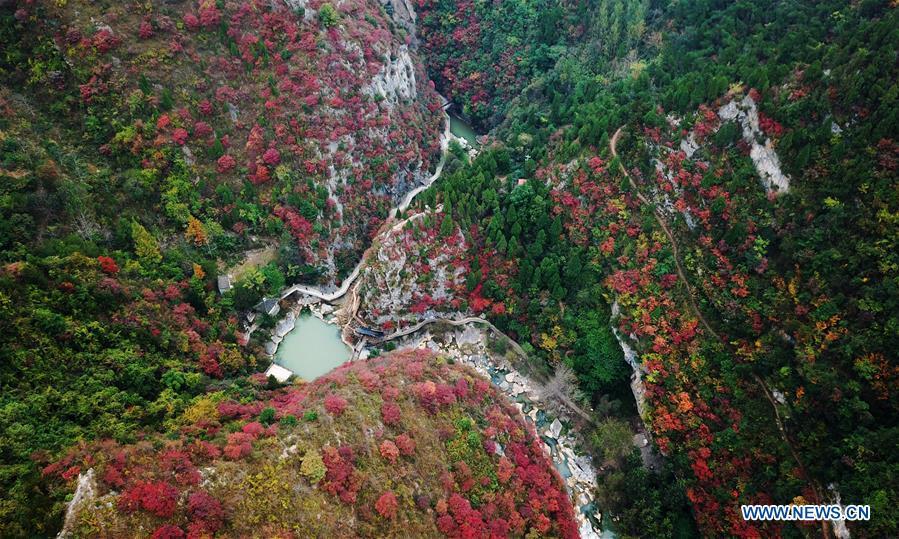
Aerial photo taken on Oct. 16, 2018 shows the autumn scenery of Xixiasong scenic area in Chengxian County of Longnan, northwest China's Gansu Province. Located in the convergence zone of the Loess Plateau, the Mongolian Plateau and the Qinghai-Tibet Plateau, Gansu Province in northwest China strides across various landforms including grasslands, forests, deserts, wetlands and mountains. In recent years, through persistent efforts on protecting water conservation area, containing desertification and resuming forests from farmlands, the ecological environment of Gansu has witnessed continuous improvement. Qilian Mountains, an important protection barrier of ecological system in western China, has nourished vast lands in the Hexi Corridor with rich snowmelt, which enables farmlands there to become a major production area of commodity grain and industrial crops. Gannan Tibetan Autonomous Prefecture in southern Gansu acts as an ecological function area for water supplement of the Yellow River and biodiversity of Qinling-Bashan mountainous regions. More than 7.3 million mu (about 486,667 hectares) of wetland in Gannan supplies over ten billion of cubic meters of water to the Yellow River. Featuring various landscapes and colorful cultures, Gansu Province has become a great attraction among tourists at home and abroad. From Aug. 25 to 27, the "Gansu Day" event is held at the ongoing Beijing International Horticultural Exhibition, in which a diversified Gansu is exhibited. (Xinhua/Chen Bin)
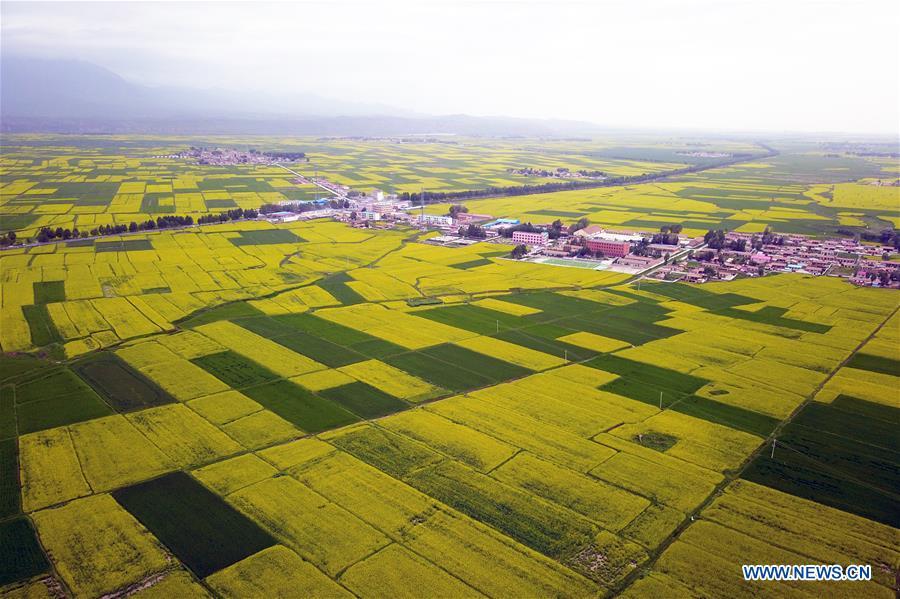
Aerial photo taken on July 17, 2019 shows cole flowers in Minle County of Zhangye City, northwest China's Gansu Province. Located in the convergence zone of the Loess Plateau, the Mongolian Plateau and the Qinghai-Tibet Plateau, Gansu Province in northwest China strides across various landforms including grasslands, forests, deserts, wetlands and mountains. In recent years, through persistent efforts on protecting water conservation area, containing desertification and resuming forests from farmlands, the ecological environment of Gansu has witnessed continuous improvement. Qilian Mountains, an important protection barrier of ecological system in western China, has nourished vast lands in the Hexi Corridor with rich snowmelt, which enables farmlands there to become a major production area of commodity grain and industrial crops. Gannan Tibetan Autonomous Prefecture in southern Gansu acts as an ecological function area for water supplement of the Yellow River and biodiversity of Qinling-Bashan mountainous regions. More than 7.3 million mu (about 486,667 hectares) of wetland in Gannan supplies over ten billion of cubic meters of water to the Yellow River. Featuring various landscapes and colorful cultures, Gansu Province has become a great attraction among tourists at home and abroad. From Aug. 25 to 27, the "Gansu Day" event is held at the ongoing Beijing International Horticultural Exhibition, in which a diversified Gansu is exhibited. (Xinhua/Fan Peishen)
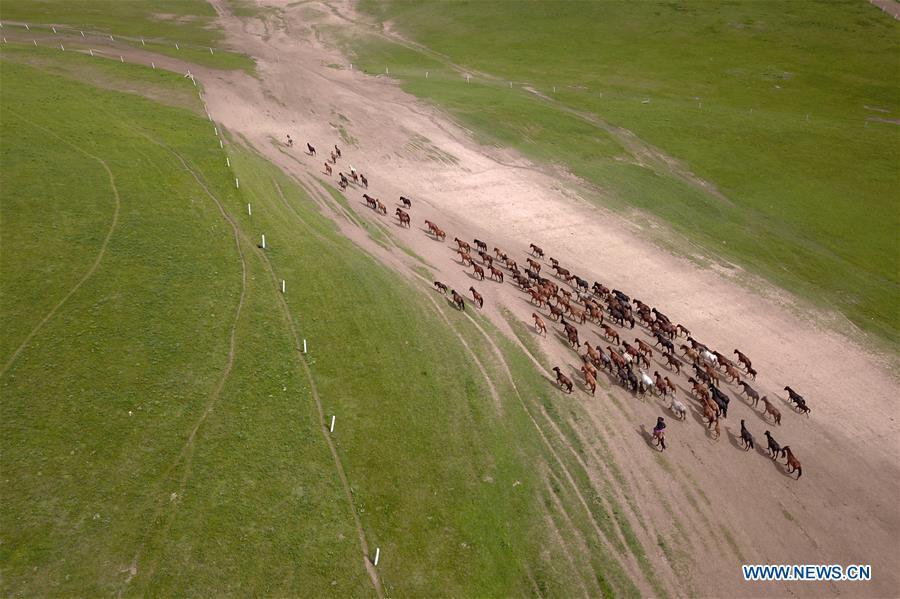
Aerial photo taken on July 17, 2019 shows a herd of horses at Shandan horse ranch in northwest China's Gansu Province. Located in the convergence zone of the Loess Plateau, the Mongolian Plateau and the Qinghai-Tibet Plateau, Gansu Province in northwest China strides across various landforms including grasslands, forests, deserts, wetlands and mountains. In recent years, through persistent efforts on protecting water conservation area, containing desertification and resuming forests from farmlands, the ecological environment of Gansu has witnessed continuous improvement. Qilian Mountains, an important protection barrier of ecological system in western China, has nourished vast lands in the Hexi Corridor with rich snowmelt, which enables farmlands there to become a major production area of commodity grain and industrial crops. Gannan Tibetan Autonomous Prefecture in southern Gansu acts as an ecological function area for water supplement of the Yellow River and biodiversity of Qinling-Bashan mountainous regions. More than 7.3 million mu (about 486,667 hectares) of wetland in Gannan supplies over ten billion of cubic meters of water to the Yellow River. Featuring various landscapes and colorful cultures, Gansu Province has become a great attraction among tourists at home and abroad. From Aug. 25 to 27, the "Gansu Day" event is held at the ongoing Beijing International Horticultural Exhibition, in which a diversified Gansu is exhibited. (Xinhua/Fan Peishen)
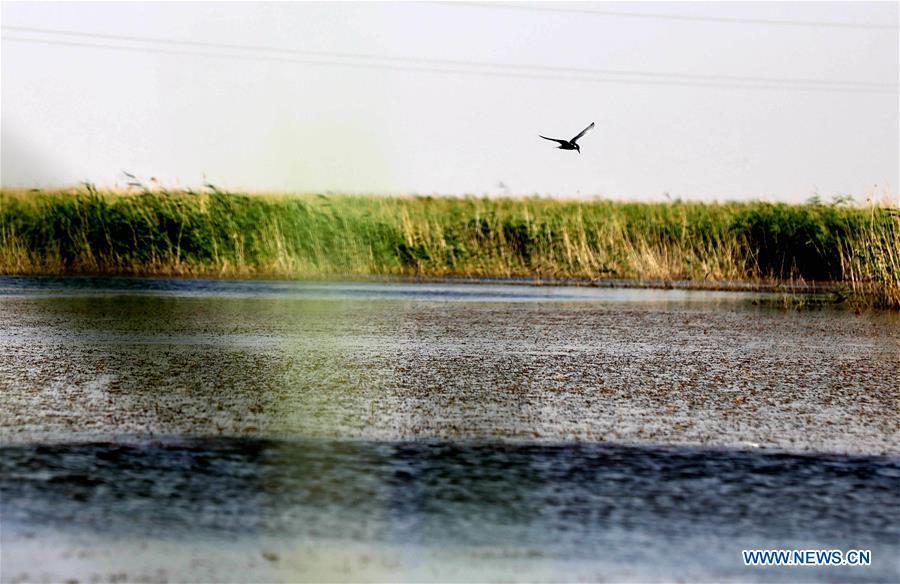
A migratory bird flies over the Qingtu Lake in Minqin County of Wuwei City, northwest China's Gansu Province, June 13, 2019. Once had been dried for around 50 years until 2010, the lake was revived due to years of desertification control efforts. Located in the convergence zone of the Loess Plateau, the Mongolian Plateau and the Qinghai-Tibet Plateau, Gansu Province in northwest China strides across various landforms including grasslands, forests, deserts, wetlands and mountains. In recent years, through persistent efforts on protecting water conservation area, containing desertification and resuming forests from farmlands, the ecological environment of Gansu has witnessed continuous improvement. Qilian Mountains, an important protection barrier of ecological system in western China, has nourished vast lands in the Hexi Corridor with rich snowmelt, which enables farmlands there to become a major production area of commodity grain and industrial crops. Gannan Tibetan Autonomous Prefecture in southern Gansu acts as an ecological function area for water supplement of the Yellow River and biodiversity of Qinling-Bashan mountainous regions. More than 7.3 million mu (about 486,667 hectares) of wetland in Gannan supplies over ten billion of cubic meters of water to the Yellow River. Featuring various landscapes and colorful cultures, Gansu Province has become a great attraction among tourists at home and abroad. From Aug. 25 to 27, the "Gansu Day" event is held at the ongoing Beijing International Horticultural Exhibition, in which a diversified Gansu is exhibited. (Xinhua/Guo Gang)
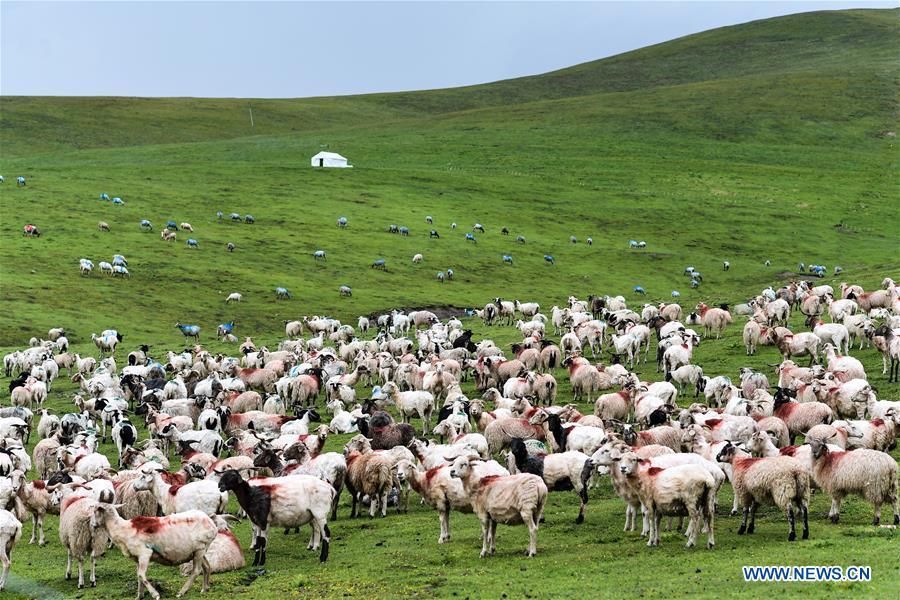
Photo taken on July 27, 2019 shows a flock of goats in a pasture at the foot of Qilian Mountains in northwest China. Located in the convergence zone of the Loess Plateau, the Mongolian Plateau and the Qinghai-Tibet Plateau, Gansu Province in northwest China strides across various landforms including grasslands, forests, deserts, wetlands and mountains. In recent years, through persistent efforts on protecting water conservation area, containing desertification and resuming forests from farmlands, the ecological environment of Gansu has witnessed continuous improvement. Qilian Mountains, an important protection barrier of ecological system in western China, has nourished vast lands in the Hexi Corridor with rich snowmelt, which enables farmlands there to become a major production area of commodity grain and industrial crops. Gannan Tibetan Autonomous Prefecture in southern Gansu acts as an ecological function area for water supplement of the Yellow River and biodiversity of Qinling-Bashan mountainous regions. More than 7.3 million mu (about 486,667 hectares) of wetland in Gannan supplies over ten billion of cubic meters of water to the Yellow River. Featuring various landscapes and colorful cultures, Gansu Province has become a great attraction among tourists at home and abroad. From Aug. 25 to 27, the "Gansu Day" event is held at the ongoing Beijing International Horticultural Exhibition, in which a diversified Gansu is exhibited. (Xinhua/Wu Gang)

Aerial photo taken on Dec. 26, 2018 shows a molten-salt solar thermal power plant in Dunhuang, northwest China's Gansu Province. Located in the convergence zone of the Loess Plateau, the Mongolian Plateau and the Qinghai-Tibet Plateau, Gansu Province in northwest China strides across various landforms including grasslands, forests, deserts, wetlands and mountains. In recent years, through persistent efforts on protecting water conservation area, containing desertification and resuming forests from farmlands, the ecological environment of Gansu has witnessed continuous improvement. Qilian Mountains, an important protection barrier of ecological system in western China, has nourished vast lands in the Hexi Corridor with rich snowmelt, which enables farmlands there to become a major production area of commodity grain and industrial crops. Gannan Tibetan Autonomous Prefecture in southern Gansu acts as an ecological function area for water supplement of the Yellow River and biodiversity of Qinling-Bashan mountainous regions. More than 7.3 million mu (about 486,667 hectares) of wetland in Gannan supplies over ten billion of cubic meters of water to the Yellow River. Featuring various landscapes and colorful cultures, Gansu Province has become a great attraction among tourists at home and abroad. From Aug. 25 to 27, the "Gansu Day" event is held at the ongoing Beijing International Horticultural Exhibition, in which a diversified Gansu is exhibited. (Xinhua/Fan Peishen)
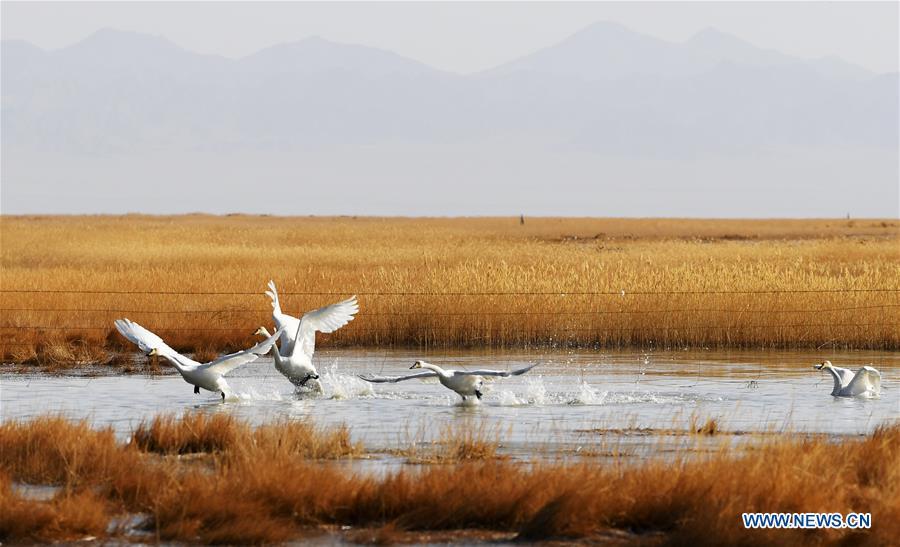
White swans fly on the Xiaosugan lake wetland in Kazak Autonomous County of Aksay, northwest China's Gansu Province, April 5, 2019. Located in the convergence zone of the Loess Plateau, the Mongolian Plateau and the Qinghai-Tibet Plateau, Gansu Province in northwest China strides across various landforms including grasslands, forests, deserts, wetlands and mountains. In recent years, through persistent efforts on protecting water conservation area, containing desertification and resuming forests from farmlands, the ecological environment of Gansu has witnessed continuous improvement. Qilian Mountains, an important protection barrier of ecological system in western China, has nourished vast lands in the Hexi Corridor with rich snowmelt, which enables farmlands there to become a major production area of commodity grain and industrial crops. Gannan Tibetan Autonomous Prefecture in southern Gansu acts as an ecological function area for water supplement of the Yellow River and biodiversity of Qinling-Bashan mountainous regions. More than 7.3 million mu (about 486,667 hectares) of wetland in Gannan supplies over ten billion of cubic meters of water to the Yellow River. Featuring various landscapes and colorful cultures, Gansu Province has become a great attraction among tourists at home and abroad. From Aug. 25 to 27, the "Gansu Day" event is held at the ongoing Beijing International Horticultural Exhibition, in which a diversified Gansu is exhibited. (Xinhua/Chen Bin)
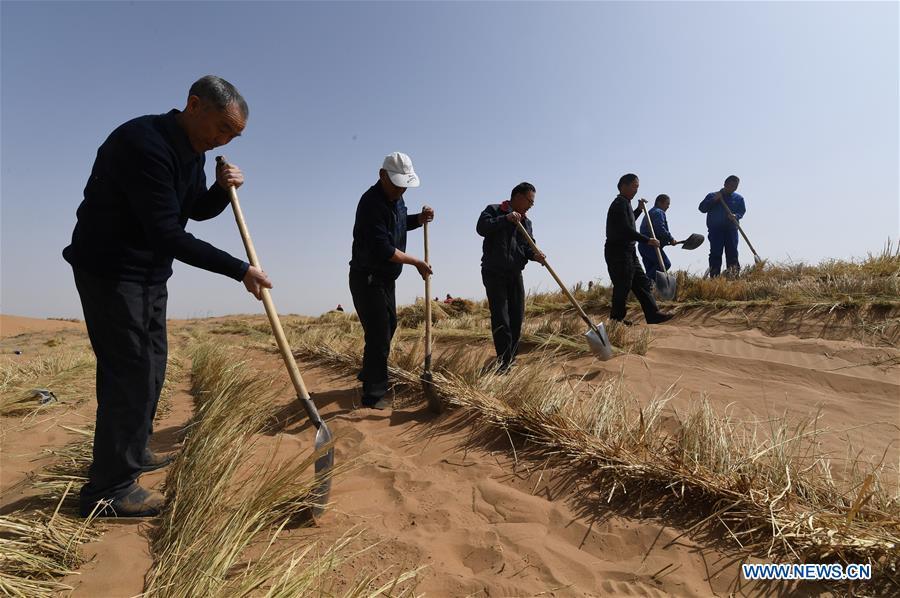
Staff members of Babusha forest farm pave straws to prevent and control desertification in Gulang County of Wuwei City, northwest China's Gansu Province, March 26, 2019. Located in the convergence zone of the Loess Plateau, the Mongolian Plateau and the Qinghai-Tibet Plateau, Gansu Province in northwest China strides across various landforms including grasslands, forests, deserts, wetlands and mountains. In recent years, through persistent efforts on protecting water conservation area, containing desertification and resuming forests from farmlands, the ecological environment of Gansu has witnessed continuous improvement. Qilian Mountains, an important protection barrier of ecological system in western China, has nourished vast lands in the Hexi Corridor with rich snowmelt, which enables farmlands there to become a major production area of commodity grain and industrial crops. Gannan Tibetan Autonomous Prefecture in southern Gansu acts as an ecological function area for water supplement of the Yellow River and biodiversity of Qinling-Bashan mountainous regions. More than 7.3 million mu (about 486,667 hectares) of wetland in Gannan supplies over ten billion of cubic meters of water to the Yellow River. Featuring various landscapes and colorful cultures, Gansu Province has become a great attraction among tourists at home and abroad. From Aug. 25 to 27, the "Gansu Day" event is held at the ongoing Beijing International Horticultural Exhibition, in which a diversified Gansu is exhibited. (Xinhua/fanpeishen)
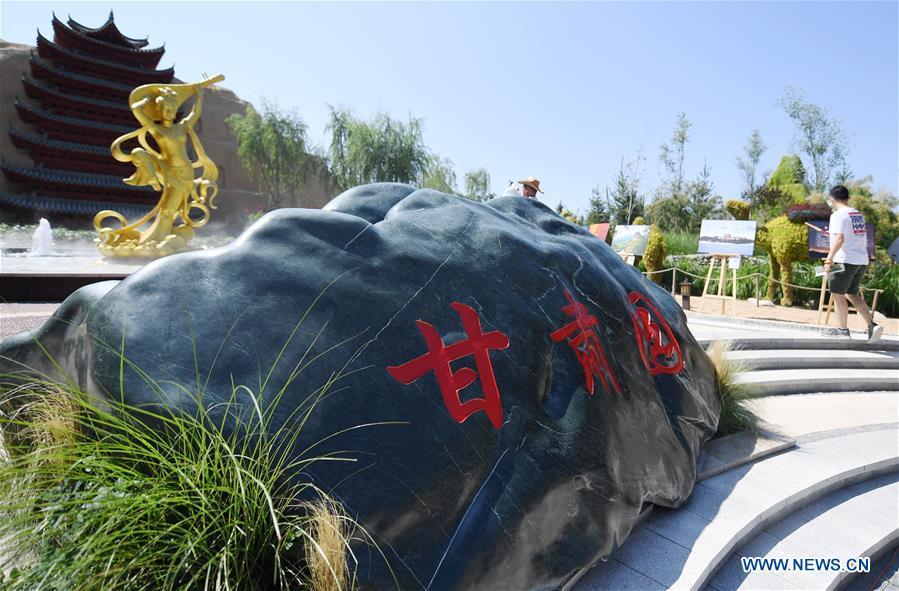
Tourists visit the Gansu Garden at the Beijing International Horticultural Exhibition in Beijing, capital of China, Aug. 25, 2019. Located in the convergence zone of the Loess Plateau, the Mongolian Plateau and the Qinghai-Tibet Plateau, Gansu Province in northwest China strides across various landforms including grasslands, forests, deserts, wetlands and mountains. In recent years, through persistent efforts on protecting water conservation area, containing desertification and resuming forests from farmlands, the ecological environment of Gansu has witnessed continuous improvement. Qilian Mountains, an important protection barrier of ecological system in western China, has nourished vast lands in the Hexi Corridor with rich snowmelt, which enables farmlands there to become a major production area of commodity grain and industrial crops. Gannan Tibetan Autonomous Prefecture in southern Gansu acts as an ecological function area for water supplement of the Yellow River and biodiversity of Qinling-Bashan mountainous regions. More than 7.3 million mu (about 486,667 hectares) of wetland in Gannan supplies over ten billion of cubic meters of water to the Yellow River. Featuring various landscapes and colorful cultures, Gansu Province has become a great attraction among tourists at home and abroad. From Aug. 25 to 27, the "Gansu Day" event is held at the ongoing Beijing International Horticultural Exhibition, in which a diversified Gansu is exhibited. (Xinhua/Zhang Chenlin)

Aerial photo taken on Aug. 22, 2019 shows the Da Haltent River in Kazak Autonomous County of Aksay, northwest China's Gansu Province. Located in the convergence zone of the Loess Plateau, the Mongolian Plateau and the Qinghai-Tibet Plateau, Gansu Province in northwest China strides across various landforms including grasslands, forests, deserts, wetlands and mountains. In recent years, through persistent efforts on protecting water conservation area, containing desertification and resuming forests from farmlands, the ecological environment of Gansu has witnessed continuous improvement. Qilian Mountains, an important protection barrier of ecological system in western China, has nourished vast lands in the Hexi Corridor with rich snowmelt, which enables farmlands there to become a major production area of commodity grain and industrial crops. Gannan Tibetan Autonomous Prefecture in southern Gansu acts as an ecological function area for water supplement of the Yellow River and biodiversity of Qinling-Bashan mountainous regions. More than 7.3 million mu (about 486,667 hectares) of wetland in Gannan supplies over ten billion of cubic meters of water to the Yellow River. Featuring various landscapes and colorful cultures, Gansu Province has become a great attraction among tourists at home and abroad. From Aug. 25 to 27, the "Gansu Day" event is held at the ongoing Beijing International Horticultural Exhibition, in which a diversified Gansu is exhibited. (Xinhua/Ma Ning)











